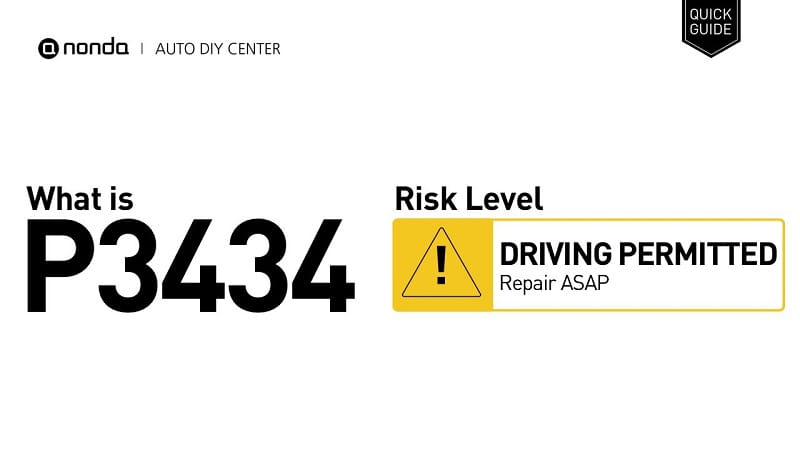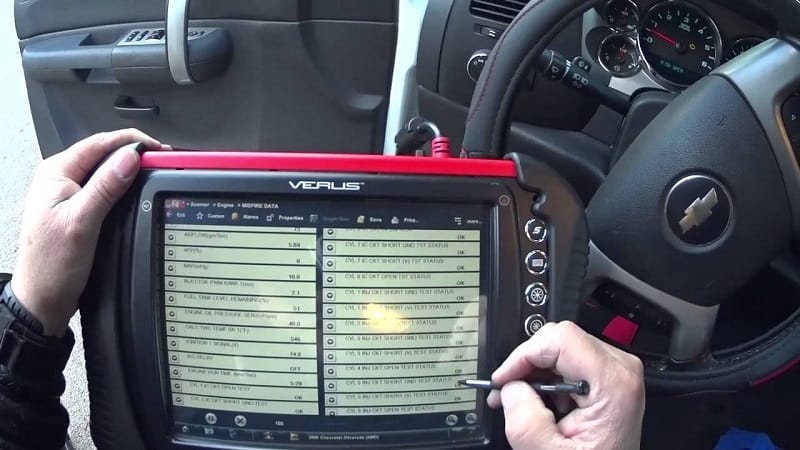This post contains affiliate links. This means I will make a commission at no extra cost to you should you click through and make a purchase [ “As an Amazon Associate, I earn from qualifying purchases.” ]. Read the full disclosure here.
Understanding Diagnostic Trouble Code P3434: Cylinder 5 Deactivation/Intake Valve Control Circuit Performance
Introduction GuideMechanic.Com The evolution of automotive engines has brought about sophisticated technologies aimed at improving fuel efficiency, reducing emissions, and enhancing performance.
One such advancement is the cylinder deactivation system, which selectively disables certain cylinders during light-load driving conditions to conserve fuel.
Central to this system is the precise control of intake and exhaust valves, regulated by solenoids controlled through electrical circuits.
When the Engine Control Module (ECM) detects an abnormality in the electrical signals related to these circuits, it triggers specific Diagnostic Trouble Codes (DTCs) to alert the technician or vehicle owner.
One such code is P3434, indicating a performance issue with the Cylinder 5 Deactivation/Intake Valve Control Circuit.
This article explores the nature of this trouble code, its causes, symptoms, diagnostic procedures, and recommended repairs.
See Also: P3435 Cylinder 5 Deactivation/Intake Valve Control Circuit Low
P3434 Cylinder 5 Deactivation/Intake Valve Control Circuit Performance
What Does DTC P3434 Mean?

DTC P3434 is defined as “Cylinder 5 Deactivation/Intake Valve Control Circuit Performance.” This code signals that the ECM has detected a deviation in the electrical performance of the intake valve control circuit responsible for cylinder 5’s deactivation.
Unlike an “open” or “short” circuit code, a performance code points to inconsistent or erratic signals from the intake valve control solenoid circuit. The ECM may observe voltage or current fluctuations that do not match the expected behavior during operation.
In simple terms, the control circuit is not functioning optimally, which can prevent the cylinder 5 intake valve from deactivating or activating correctly.
How the Cylinder 5 Intake Valve Control Circuit Works
To understand P3434, it helps to know the role of the intake valve control circuit:
- The intake valve control solenoid is an electromechanical device that regulates oil flow to the intake valve lifters.
- The ECM sends electrical signals to the solenoid to engage or disengage the intake valve operation on cylinder 5.
- This operation enables cylinder deactivation, where intake valves remain closed to shut down combustion in that cylinder during specific driving conditions.
- The solenoid’s performance depends on consistent voltage, current, and response times, monitored continuously by the ECM.
- If the ECM detects irregularities in the circuit’s response (e.g., slow activation, voltage spikes, or intermittent signals), it triggers P3434.
P3434 Cylinder 5 Deactivation/Intake Valve Control Circuit Performance
Symptoms of P3434
When the Cylinder 5 Intake Valve Control Circuit shows performance issues, several symptoms may present, including:
- Illumination of the Check Engine Light (CEL)
- Engine running rough or misfiring, especially at low loads
- Reduced fuel efficiency due to loss of proper cylinder deactivation
- Engine hesitation or uneven acceleration
- Noticeable reduction in power
- Possible increase in emissions
- In some cases, a noticeable noise or rattle from the valve train area
Symptoms may worsen during conditions where cylinder deactivation is active, such as highway cruising or light throttle application.
Common Causes of P3434
Performance-related trouble codes like P3434 can stem from various underlying issues:
1. Intermittent Wiring or Connector Issues
Loose, corroded, or damaged connectors and wiring can cause inconsistent electrical signals, leading to performance errors.
2. Failing Intake Valve Control Solenoid
A solenoid beginning to fail may exhibit erratic behavior, such as delayed response or partial activation, causing fluctuating circuit performance.
3. Low or Fluctuating Voltage Supply
Issues with the vehicle’s battery, alternator, or fuse circuit can cause voltage drops or spikes, impacting the solenoid’s operation.
4. Faulty ECM/PCM
Though less frequent, an ECM malfunction can lead to incorrect signal processing or output irregularities.
5. Mechanical Problems Affecting Valve Operation
Oil contamination, sludge buildup, or mechanical wear in the valve train can impair solenoid effectiveness, reflected in electrical performance deviations.
P3434 Cylinder 5 Deactivation/Intake Valve Control Circuit Performance
Diagnosing DTC P3434

Diagnosing performance issues requires careful, step-by-step troubleshooting:
Step 1: Scan and Confirm the Code
Use a reliable OBD-II scanner to confirm P3434 and check for additional related codes.
Review freeze frame data to understand operating conditions when the fault occurred.
Step 2: Visual Inspection
Inspect wiring and connectors related to the cylinder 5 intake valve control solenoid.
Look for signs of damage, corrosion, or loose terminals.
Step 3: Check Electrical Signals
Using a multimeter or oscilloscope, monitor voltage and current to the solenoid during engine operation.
Compare readings against manufacturer specifications to identify fluctuations or abnormalities.
Step 4: Test Solenoid Resistance and Operation
Measure the solenoid coil resistance; deviations from spec indicate internal faults.
Activate the solenoid directly with a controlled power supply to verify mechanical response.
Step 5: Inspect Power Supply and Ground Circuits
Verify stable power supply voltage and proper grounding.
Check fuses and relays associated with the valve control circuit.
Step 6: ECM Output Verification
Utilize bi-directional control via scan tool to command solenoid ON/OFF.
Observe if ECM commands produce expected electrical and mechanical responses.
P3434 Cylinder 5 Deactivation/Intake Valve Control Circuit Performance
Repair and Maintenance Procedures
Once the root cause is identified, appropriate repairs or replacements can be undertaken:
1. Repair or Replace Wiring and Connectors
Repair damaged wiring harnesses with proper splicing and insulation.
Replace corroded or damaged connectors to ensure solid electrical connections.
2. Replace the Intake Valve Control Solenoid
A solenoid exhibiting faulty or erratic operation should be replaced with an OEM-quality component.
3. Restore Proper Power and Ground
Replace blown fuses or faulty relays.
Clean and tighten ground connections.
4. ECM Service
If the ECM is suspected to be defective, professional evaluation and reprogramming or replacement may be necessary.
5. Mechanical Inspection and Maintenance
Perform oil changes and use high-quality engine oil to prevent sludge buildup.
Inspect the valve train for mechanical wear or damage.
Replace worn components to restore proper mechanical operation.
P3434 Cylinder 5 Deactivation/Intake Valve Control Circuit Performance
Can You Drive With P3434?
While it is possible to drive a vehicle with DTC P3434 active, it is not advisable:
- Fuel economy will likely be reduced due to the loss of cylinder deactivation.
- Engine performance may suffer, causing rough running or hesitation.
- Prolonged driving with the issue could lead to further engine damage.
- Emission levels may increase, potentially causing failed emission tests.
- Addressing the issue promptly ensures better fuel efficiency, engine longevity, and compliance with emission standards.
Preventive Tips to Avoid P3434
Follow regular engine maintenance schedules, including oil and filter changes.
Inspect wiring harnesses and connectors periodically for damage or corrosion.
Avoid aftermarket modifications that may interfere with valve control circuits.
Use quality replacement parts to ensure reliability.
Keep the engine bay clean and dry to prevent moisture-related electrical issues.
Conclusion
Diagnostic Trouble Code P3434 points to a performance issue in the Cylinder 5 Deactivation/Intake Valve Control Circuit.
This code highlights electrical irregularities that prevent the intake valve solenoid from operating as intended, potentially disrupting cylinder deactivation, fuel economy, and engine performance.
A thorough understanding of this system, combined with careful diagnostic procedures—covering wiring, connectors, solenoids, power supplies, and ECM functions—allows effective troubleshooting and repair.
By addressing P3434 promptly and correctly, vehicle owners and technicians can ensure that the advanced valve control system continues to operate efficiently, helping modern engines deliver the fuel savings and performance benefits they were designed for.
- Custom Lifted Diesel Trucks for Sale - December 20, 2025
- New Lifted Diesel Trucks for Sale - December 19, 2025
- Old Lifted Diesel Trucks for Sale - December 18, 2025
